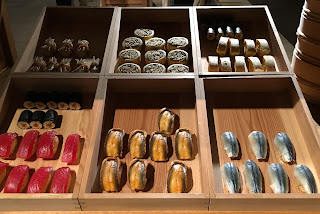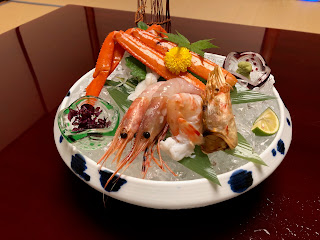--Susan, every other Sunday
While many people outside Japan (and some who live here, too) use the terms sushi and sashimi interchangeably, they're actually quite different. Sashimi (刺身) translates "pierced body," and refers to sliced meat or fish presented over or beside a garnish.
 |
| Sashimi at Marukoma Ryokan, Hokkaido |
By contrast, sushi refers to vinegared rice served with (often topped by) other ingredients, which can (and often does) include raw fish. Traditionally, sushi was much larger than it is today, and was sold from carts as a quick, mobile meal for workers.
 |
| A display of traditional Edo-period sushi (Edo-Tokyo Museum) |
 |
| Edo-period woodblock print of sushi stands near Edo harbor |
Since I'm allergic to fish, most sushi is problematic--not only because the rice is often topped with fish, but because some restaurants use bonito-based dashi (soup stock) when preparing the vinegared rice.
That said, and as counterintuitive as it might seem, I usually can eat sashimi--which is good, because it's one of the most important courses in a traditional Japanese kaiseki meal.
Because the identifying characteristics of sashimi are (1) thinly-sliced food, served raw and cold, and (2) a beautiful garnish, Japanese chefs riff widely on the theme, even when they're not accommodating an allergy.
The offerings range from the highly traditional:
 |
| Turbo Snail Sashimi (Wakayama Prefecture) |
 |
| Basashi (horsemeat sashimi - Kaida Plateau, Kiso, Nagano Prefecture) |
 |
| Prawn and scallop sashimi (Iwate Prefecture) |
To modern:
 |
| Konjac vegetarian sashimi, Ryokan Iwaso (Miyajima, Hiroshima Prefecture) |
 |
| Yuba Sashimi - KAI Kinugawa (Kinugawa Onsen, Tochigi Prefecture) |
 |
| Avocado and Yuba (tofu skin) sashimi, Ryokan Iwaso (Miyajima, Hiroshima Prefecture) |
Vegetarian sashimi--like the versions shown above, is not uncommon; in fact, Buddhist temples have been serving vegan versions of sashimi as part of shojin ryori (Buddhist temple cuisine) for thousands of years:
 |
| Konjac sashimi - Ekoin Temple, Koyasan |
 |
| Mixed sashimi - Ekoin temple, Koyasan (Wakayama Prefecture) |
Despite knowing that sashimi had deep roots in Japanese culinary history, I'd never eaten it before coming to Japan, in part because the varieties available in the United States generally involve raw fish. The range of sashimi available in Japan makes it far easier to taste and enjoy--not only for allergy reasons but also because it's more approachable for people who might not be quite ready to dive in and eat the fish-based kinds.
That said, I'll admit the snail was more than a little challenging (and doesn't get better, at least for me, even though I've eaten it more than once), and the idea of eating horses is off-putting for many people too (there's a story behind why I like it, which I'll share at a different time). I haven't met anyone yet who objected to vegetables, though, and yuba sashimi has even converted some non-tofu eaters I know into yuba fans.
Taste aside, sashimi is food elevated to an art, in terms of execution and presentation as well as taste--and usually as beautiful to behold as it is to eat.
 |
| Celebration sashimi, Nishimuraya Honkan, Kinosaki Onsen, Hyogo Prefecture |
To answer a couple of last, unspoken questions: Yes, I did take all of the pictures and eat all of the dishes pictured in this post--and No, I don't have a favorite among them. With the exception of the snail (for which "challenging" is putting it mildly) I enjoyed them all immensely.
Now I'd like to know: which one would you most like to try?



























You ask which ONE I would most like to try: the snail, of course. I've never had it. Nor the horse meat. I'll try anything. must admit I was salivating profusely before I reached the end of your marvellous blog.
ReplyDeleteYou know what I’m going to say, Susan. Fan of Japanese cooking that I have been in the past, I just wish I could still eat any of it. The best I can do is enjoy your gorgeous photography! And it is gorgeous!
ReplyDeleteYour photos are delicious! I love shojin ryori too. I think Horses were companion workers in the West much like Oxen were in the East--so eating horse meat might feel as off putting to some Westerners as eating beef to some Easterners?
ReplyDeleteWhen I moved to NYC 1000 years ago, an elegant, upscale Japanese restaurant across the street from the law firm where I worked became the in-place for associates to eat their late evening meals (on the firm for those working to around midnight). It was there that I learned how to use chopsticks and all about sushi, sashimini, sake and sex. Nah, only kidding about the last category, though rumor had it there were several places in the UN area where that was a delicacy of the house.
ReplyDeleteMy personal favorite was -- and still is -- Oshinko aka Japanese pickled vegetables.